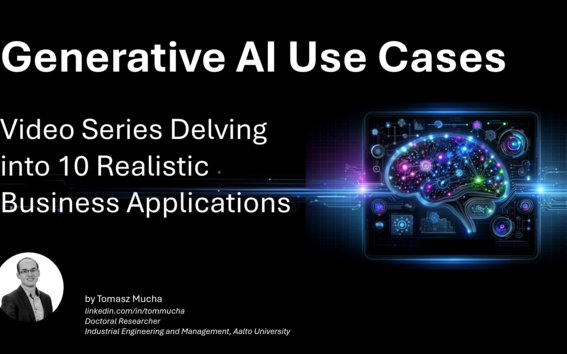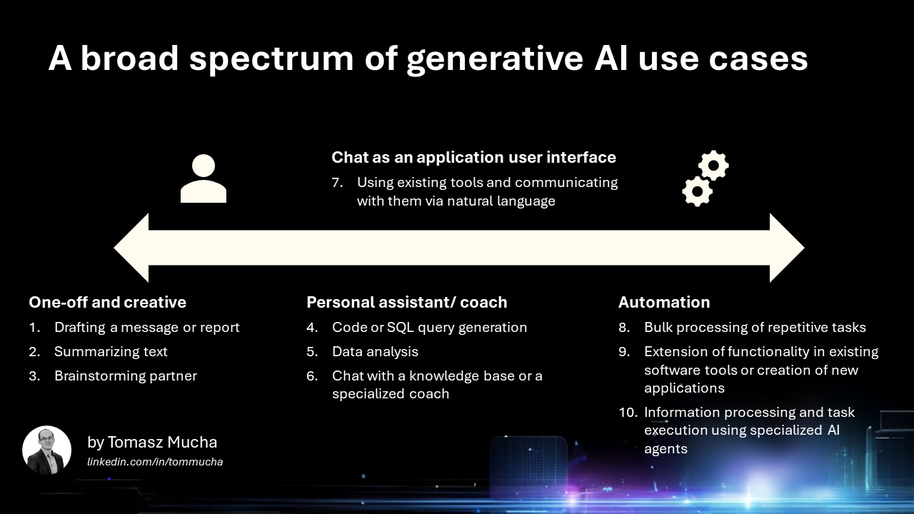Generative AI Use Cases: Video Series Delving into 10 Realistic Business Applications
Welcome to a video series exploring the practical applications of generative AI in business. Join me as we journey through a diverse range of concrete use cases. Starting with creative applications and transitioning to continuous use cases, we'll also touch on emerging trends like generative AI's role in user interface design.

My aim is to demystify the power of generative AI by providing tangible examples and insights for professionals at every level and across various business functions. Whether you're seeking to streamline processes or enhance creativity, join me in exploring the business potential of generative AI. Feel free to sequentially progress through the content or dive into topics that interest you most. And, don't forget to share your insights with colleagues. Welcome aboard!
I have divided the use cases for generative AI into four categories:
- One-off and creative
- Personal assistant/coach
- Chat as an application user interface
- Automation
While there is going to be some overlap between these categories, they are still useful in terms of guiding our journey. The videos progressively cover increasingly complex use cases. This is not to say, however, that the earlier ones present less of a business opportunity than the latter ones. Rather, they become fundamental building blocks of more complex or automated uses cases.

One-off and creative use cases of generative AI
1. Drafting a message or report
This video shows how to use generative AI to increase the productivity of business writing. The use cases I cover include writing of a recommendation letter and drafting a status update report for a management team.
The tools I use in this video are:
You can find the prompts used in this video here.
2. Text summarization
In this video I show how generative AI tools can be used to save time by generating summaries of written content. I cover three types of summaries: simple, tailored to specific audience, and advanced/complex.
The tool I use in this video is:
You can find the prompts used in this video here.
3. Brainstorming
In this video I show how generative AI tools can be used to boost the idea generation process of brainstorming through interactive back-and-forth exchange and follow-up questions. I cover a concrete examples: creating ideas for team-building activities at a company event.
The tools I use in this video is a custom GPT:
You can find the initial prompt used in this video here.
It is possible to replicate the behavior of Innovator using other tools (including those that are free to use). It requires more guiding prompts which tell more explicitly about the desired steps in the idea generation process.
Personal assistant or coach
4. Code generation
In this video I show how generative AI tools can be used to speed up the process of writing code (even if you are not a programmer). I cover a concrete example: automating the analysis of multiple PDF documents with the help of a simple python script.
The tool I use in this video is:
You can find the sample data and prompt used in this video here.
5. Data analysis
In this video I demonstrate how generative AI tools can be used when performing data analysis in business context. The interaction with generative AI has the potential to boost analytics capabilities of businesses, because it enables performing analysis in real time via natural language commands. In this video I analyze multiple Excel files - perform calculations, generate new tables and charts without coding or writing any formulas.
The tool I use in this video is:
You can find the sample data and prompts used in this video here.
6. Chat with a knowledge base or a specialized coach
In this video I show how generative AI tools can be used to speed up the access to business knowledge base. I cover two concrete examples:
1. I create a chatbot which generates answers that draw on a knowledge base of Slack FAQ documents - I provide these documents specifically for that purpose. This technique is called retrieval augmented generation (RAG) and is increasingly popular way for customizing LLM outputs and reducing the problem of hallucination. 2. I create a custom GPT which is specialized in answering questions regarding the implementation of ISO9001 quality management standard in supply chain.
The tools I use in this video are:
You can find the sample data and prompts used in this video here.
Personal assistant or coach
7. Chat as an application user interface
In this video I show how generative AI tools can be used to remove friction from the interactions between users and software applications. I cover a concrete example: I compare the creation of a business process automation using Zapier's classic (click and drop-down based) and natural language interface.
Automation
8. Bulk processing of repetitive tasks
In this video I show how generative AI tools can be used to automate various business tasks. I cover three concrete examples: 1. Evaluating whether scans of documents show appropriately filled in certificates of origin (documents used in international trade). 2. Performing analysis of business outlook summaries for multiple customers to determine potential impact on supply chain - everything is done from within Excel. 3. Automatically generating a report which condenses and extracts insights from the results of an online survey.
The tools I use in this video are:
- ChatGPT
- OpenAI developer API
- Excel
- Google Forms, Sheets, and Docs
- Pipedream
You can find the sample data and prompts used in this video here.
9. Extension of functionality in existing software (new feature prototyping)
In this video I show how generative AI tools can be used to extend the functionality of existing software. I also include a bonus tip on how to rapidly prototype such new features without any coding. I cover a concrete example of prototyping a new feature in a purchase order approval tool. The new functionality enables identification of new emerging risks related to the order and creation of follow up emails, if risks are identified.
The tools I use in this video are:
- Excel
- Copilot on Edge browser
You can find the sample data and prompts used in this video here.
10. Information processing and task execution using specialized AI agents or AI assistants
In this video I show how generative AI tools can be used to automate multi-step business processes with the help of specialized AI assistant that collaborate with each other. I cover a concrete example of process automation within a sales management team. I show how AI assistants can participate in the following process:
- identify potential customers
- validate the suitability of the sales leads according to the definition of the target market
- do a preliminary evaluation of customer needs
- assign the sales leads to sales representatives according to their profile
- upload this information to an existing database of sales leads.
The tools I use in this video are:
- OpenAI developer API
- Pipedream
- Notion database
- Google Sheets
You can find the sample data and prompts used in this video here.
Concluding remarks
This video series aimed to showcase concrete business use cases for generative AI. The presented examples are neither comprehensive nor intended to be production-ready implementations. Instead, the goal was to explore a diverse range of potential applications, striking a balance between simplicity and practical relevance.
Unlocking the business value of generative AI and mitigating the risks associated with this evolving technology requires a broader understanding of its potential applications. By demystifying its use cases, we can collectively move forward.
Thank you for joining me on this journey. I encourage you to attempt replicating some of the examples or conducting your own experiments. Regardless of the outcome, you are guaranteed to either achieve success or gain valuable insights.
Tomasz Mucha is a doctoral researcher at the Department of Industrial Engineering and Management at Aalto University School of Science.
Show other posts from this blog

Haluatko pelastaa maailman ja tulla miljonääriksi? Katse omaan napapaitaan!
Jari A.T. Laine ja Timo Seppälä tarkastelevat kestävän kehityksen ympärillä tapahtuvan uuden teollisen kierron haasteita.
Suomen innovaatiorahoitus osa 2 - Kaiken takana on jalostusarvo
Miten ymmärrys jalostusarvosta muuttaa näkymäämme suomalaisiin yrityksiin, pohtivat Jari Laine, Matti Pihlajamaa ja Timo Seppälä.
PUOLIJOHDEBAROMETRI 2/2024 – Seuraavan sukupolven puolijohteet
Puolijohdeteollisuuden pitkät teknologiasyklit ja pääomaintensiivisyys huomioitava tutkimusrahoituksessa, kirjoittavat tutkijat.